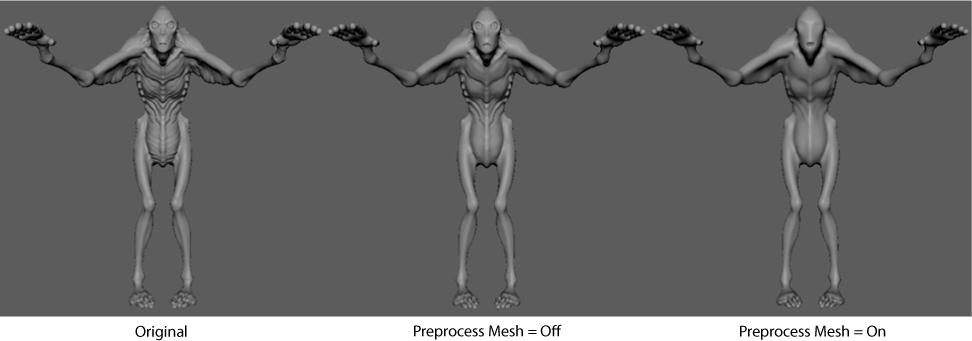- Mesh > Retopologize >
 > Preprocess Mesh
> Preprocess Mesh
- polyRetopo node (Attribute Editor) > Settings > Preprocess Mesh

Model provided by: Christoph Schädl
Preprocess Mesh optimizes dense input meshes to speed up and increase the success of the Retopologize operation.
Best practices
|
Best practice |
Additional information |
|---|---|
|
Use with a high resolution input mesh |
The Preprocess Mesh option is specifically designed for input meshes with high triangle counts (100k+). These meshes may also contain topological noise and mesh defects. Preprocess Mesh may not be beneficial if used with low resolution meshes with clean geometry. If you are working with a low resolution mesh (under 100k faces), consider disabling Preprocess Mesh before running Retopologize. |
|
In the Retopologize Options or polyRetopo node, set Target Face Count to 50% or less than the face count of the input mesh |
If the Target Face Count value is set to 50% of (or higher than) the face count of the input mesh and Preprocess Mesh is turned on, running Retopologize may be slow or cause unnecessary smoothing on your mesh. To mitigate this issue, turn off Preprocess Mesh and run Retopologize again. |
When to use Preprocess Mesh vs. Remesh
| Scenario |
Preprocess Mesh |
Remesh |
|---|---|---|
| High resolution input mesh with clean topology |
Although you can use both Preprocess Mesh and Remesh in this scenario, Preprocess Mesh produces results faster. |
|
| High resolution input mesh with detail that you want to preserve |
Preprocess Mesh optimizes dense meshes by smoothing them, which may result in a loss of detail. You can try running Remesh to achieve more predictable results when you run Retopologize. |
|
| High resolution input mesh with lots of detail and hitting a low Target Face Count is priority | 
The Retopologize algorithm prioritizes details of the input mesh over face count. Preprocess Mesh smooths out the details of your mesh, making it easier for the algorithm to hit a low Target Face Count. If hitting a low Target Face Count is your top priority, ensure that Preprocess Mesh is turned on when you run Retopologize. |
|
| Running Retopologize with Preprocess Mesh turned on is not producing expected results |
When you encounter problems or errors, turn off Preprocess Mesh and run Remesh before running Retopologize again. |